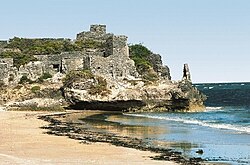Ajuran Sultanate
The Ajuran Empire (Somali: [Dawladdii Ajuuraan] Error: {{Lang}}: text has italic markup (help), Arabic: دولة الأجورانية), also spelled Ajuuraan Empire,[1] and often simply as Ajuran,[2] was a Somali empire in the medieval times that dominated the Indian ocean trade. They belonged to the Somali Muslim sultanate[3][4] that ruled over large parts of the Horn of Africa in the Middle Ages. Because of their centralized administration and strong military, they were able to resist an attack by the Ottoman empire. This was called Gaal Madow. The fought a number of wars with the Portugese, and were able to withstand them. After the war, trade routes were re-established or strengthened. In the coastal provinces, trade flourished. Ships sailed to and came from many kingdoms and empires in East Asia, South Asia, Europe, the Near East, North Africa and East Africa.[5]
Ajuran Empire Dawladdii Ajuuraan دولة الأجورانية | |||||||||||
|---|---|---|---|---|---|---|---|---|---|---|---|
| 13th century–late 17th century | |||||||||||
 The Ajuuraan Empire in the 15th century | |||||||||||
| Capital | |||||||||||
| Common languages | Somali · Arabic | ||||||||||
| Religion | Sunni Islam | ||||||||||
| Government | Monarchy | ||||||||||
| Sultan, Imam | |||||||||||
| History | |||||||||||
• | 13th century | ||||||||||
| 1538–57 | |||||||||||
| 1580–89 | |||||||||||
| Mid-17th century | |||||||||||
• | late 17th century | ||||||||||
| Currency | Ajuran • Mogadishan | ||||||||||
| |||||||||||
| Today part of | |||||||||||
The empire was very important, and built many castles and fortresses. Some of them can still be seen, mostly in the southern part of Somalia. There are also a number of pillar tombs, necropolises, and cities built during that era, which are now in ruins, which are attributed to Ajuran engineers.[5] During the Ajuran period, many regions and people in the southern part of the Horn of Africa converted to Islam because of the theocratic nature of the government.[6] The royal family, the House of Garen, expanded its territories and established its hegemonic rule through a skillful combination of warfare, trade linkages and alliances.[7]
The Ajuran also controlled the water resources. They built wells and cisterns on the rivers Shebelle and Jubba. Many of these wells are still working. The rulers also developed a new system of agriculture and taxation, which were used in parts of the Horn of Africa until the 19th century.[1] The later rulers of the Ajuran were not as successful: There were rebellions, and by the late 17th century the empire had fallen apart into a number of smaller states. The most prominent of these was probably the Geledi Sultanate.[8]
Ajuran Sultanate Media
The city of Merca was one of several prominent administrative centers of the Ajurans.
Mogadishu imported valuable gold Sequin coins from the Venetian Empire in Europe.
The Ajuran Empire maintained commercial ties with the Ming dynasty and other kingdoms.
Medieval city of Barawa
References
- ↑ 1.0 1.1 Njoku, Raphael Chijioke (2013). The History of Somalia. Greenwood. p. 40. ISBN 978-0-313-37857-7.
- ↑ "Ajuran | historical state, Africa". Encyclopedia Britannica.
- ↑ Luling, Virginia (2002). Somali Sultanate: the Geledi city-state over 150 years. Transaction Publishers. p. 17. ISBN 978-1-874209-98-0.
- ↑ Mukhtar, Mohamed Haji (1989). "The Emergence and Role of Political Parties in the Inter-River Region of Somalia from 1947–1960". Ufahamu. 17 (2). doi:10.5070/F7172016882.
- ↑ 5.0 5.1 Shelley, Fred M. (2013). Nation Shapes: The Story behind the World's Borders. ABC-CLIO. p. 358. ISBN 978-1-61069-106-2.
- ↑ Ramsamy, Edward, ed. (2012). Cultural Sociology of the Middle East, Asia, and Africa: An Encyclopedia. Vol. 2: Africa. SAGE Publications. ISBN 978-1-4129-8176-7.
- ↑ Pouwels, Randall L. (2006). Horn and Crescent: Cultural Change and Traditional Islam on the East African Coast, 800–1900. African Studies. Vol. 53. Cambridge University Press. p. 15. ISBN 9780521523097.
- ↑ Njoku (2013).









